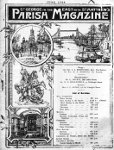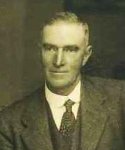

 A decade of parish life: from the magazine, 1923-34
A decade of parish life: from the magazine, 1923-34
(5) Maintenance & repairs, parish finance, the Fête
Church maintenance and repairs
 But
problems beyond the abilities of the home team were looming. In 1924
the church roof was inspected to check for the spread of death watch
beetle - no easy job: the roof is dark, very dirty indeed from the
liberal supply of soot delivered continually from our neighbours'
chimneys - and advice was sought from Professor Maxwell Lefroy of the
Imperial College of Science, the authority on the subject. His
recommendation was clean all the timber with a vacuum cleaner and then
paint it over with oil containing a volatile poison which will diffuse
itself at once through the wood and kill and grubs at present alive in
it, and a permanent poison which will kill any grubs coming out in the
beetle form, as well as any beetle which tries to lay eggs in the wood
or any eggs laid. Professor Lefroy has a fly farm - the only one,
happily! in England - on the roof of the College of Science, where he
tests insect killers and everybody who has a brain-wave on the subject
brings it to him to be tested. He is therefore the right man to
recommend a good lotion for our timber and he has done so. But the
first thing is to get hold of a vacuum cleaner and get busy.
But
problems beyond the abilities of the home team were looming. In 1924
the church roof was inspected to check for the spread of death watch
beetle - no easy job: the roof is dark, very dirty indeed from the
liberal supply of soot delivered continually from our neighbours'
chimneys - and advice was sought from Professor Maxwell Lefroy of the
Imperial College of Science, the authority on the subject. His
recommendation was clean all the timber with a vacuum cleaner and then
paint it over with oil containing a volatile poison which will diffuse
itself at once through the wood and kill and grubs at present alive in
it, and a permanent poison which will kill any grubs coming out in the
beetle form, as well as any beetle which tries to lay eggs in the wood
or any eggs laid. Professor Lefroy has a fly farm - the only one,
happily! in England - on the roof of the College of Science, where he
tests insect killers and everybody who has a brain-wave on the subject
brings it to him to be tested. He is therefore the right man to
recommend a good lotion for our timber and he has done so. But the
first thing is to get hold of a vacuum cleaner and get busy. The
Ecclesiastical Commissioners promised a grant, and approved an
architect, W. Charles Waymouth FRIBA (1872-1967) [pictured], who wanted the gutters
lifted so that damage where the roof beams met the stonework could be
inspected (for which dry weather was needed). He did not complete his
full examination until early 1929, and reported that much urgent work,
at an estimated cost of £3000, was needed. As well as the death
watch beetle, the lead roof was leaking, and stonework of the towers
and cupolas needed repointing and strengthening. We can't do all the
work ourselves, but are ready to do our share, said the Rector, and he
hoped that grants would be forthcoming. A wider appeal would be needed,
for which the bicentenary that year was a first opportunity. In
October that year, the Architect assures us that the roof is is really
in a serious condition, and is likely to 'let the weather through' at
any time... A grant of £500 had been promised, £32 had been received
in donations, and £100 was earmarked from the proceeds of the fête.
Collecting boxes for the Bicentenary Restoration Fund were introduced
the following year, which produced about £12 a month. By July 1930
£1000 had been raised or promised.
The
Ecclesiastical Commissioners promised a grant, and approved an
architect, W. Charles Waymouth FRIBA (1872-1967) [pictured], who wanted the gutters
lifted so that damage where the roof beams met the stonework could be
inspected (for which dry weather was needed). He did not complete his
full examination until early 1929, and reported that much urgent work,
at an estimated cost of £3000, was needed. As well as the death
watch beetle, the lead roof was leaking, and stonework of the towers
and cupolas needed repointing and strengthening. We can't do all the
work ourselves, but are ready to do our share, said the Rector, and he
hoped that grants would be forthcoming. A wider appeal would be needed,
for which the bicentenary that year was a first opportunity. In
October that year, the Architect assures us that the roof is is really
in a serious condition, and is likely to 'let the weather through' at
any time... A grant of £500 had been promised, £32 had been received
in donations, and £100 was earmarked from the proceeds of the fête.
Collecting boxes for the Bicentenary Restoration Fund were introduced
the following year, which produced about £12 a month. By July 1930
£1000 had been raised or promised.| Quotas It may be useful to explain what this word means. The London Diocesan Fund exists to provide additional clergy and other Church-workers for the poor parishes of London. It does its best to provide for some other necessary works too, but these are what mainly concern us here. It has no funds expect what it gets from voluntary offering, and its work therefore grows, or stands still, or fails, according as Church people give or do not give it what it needs. Its plan for some years has been to make an estimate at the beginning of each year as to what money is needed and to let each Rural Deanery know what it is felt fait to ask it to give towards this. This amount asked from a Deanery is the 'Deanery quota'. On receiving notice of this quota the Ruri-Decanal Conference in its turn, and guided by its Finance Committee, decides what each parish in the Deanery may fairly be asked to give towards this sum. This is the 'parochial quota'. This year the estimated sum for the Diocese is £88,500, and the Deanery of Stepney (which means the parishes in the Borough of Stepney) are asked to provide at least £705, and if possible £823 towards this. The share asked from our parish is at least £13 10s. and if possible £15 15s. This share is our 'quota'; what we should at least provide is called our 'quota of obligation'; what we should if possible provide is our 'quota of ambition.' It has been our practice for some years to pay the 'quota of obligation' out of our ordinary Church funds, and then to let the offerings of the Week of Prayer make up the 'quota of ambition'. Last year and the year before we went beyond our 'quota of ambition', and gave more than we were asked. I hope we shall do so again, for every penny we can gives is needed and goes to help good work. I may add that our parish receives from the Diocesan Fund very much more than we can possibly give to it. Our grants from the Fund are £200 a year. Last year we gave to it £19 8s. 5d. |
|
| Some comments 1923: Do not forget what a wonderful view of London and the Thames is obtainable from the top of the Church Tower, where Mr Warncken, the steeplekeeper, will take you in safety and comfort and lend you a telescope at the top. 1925: planning was delayed by the wait for the new Rector, so takings were down; he commented that far from interfering with Sunday attendance, communicants were up, and he expressed particular thanks to the Misses Hoare who brought to Town as much of the country as they could for the purposes of the sale. 1927: wet weather, but cleared up by noon on each of the three days so no goods got wet 1929: the fête was on Thursday and Saturday, leaving Friday free for the bicentenary service. The grounds looked their best, and the illumination which our electricians devised for the evenings was a great boon to the later hours. Saturday ended with a thunderstorm 1932: more successful than some of us had dared to hope in these depressing days - attendance was never large, but people spent generously 1933: the fête was linked with a Thanksgiving Service for the completion of restoration work; it was beset with thunderstorms and torrents of rain - and did not open until 6pm on the Saturday; surplus goods were sold 'privately' over the following weeks, but profits were reduced to £85. Mr Schneider kindly exhibited his wonderful model of the church for funds. |
Back to History page | A Decade of Parish Life (1) | A Decade of Parish Life (2) | A Decade of Parish Life (3) | A Decade of Parish Life (4)